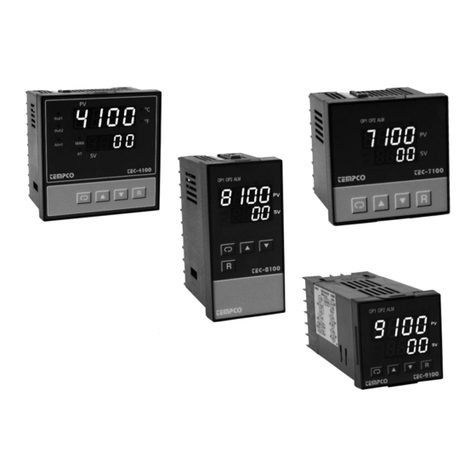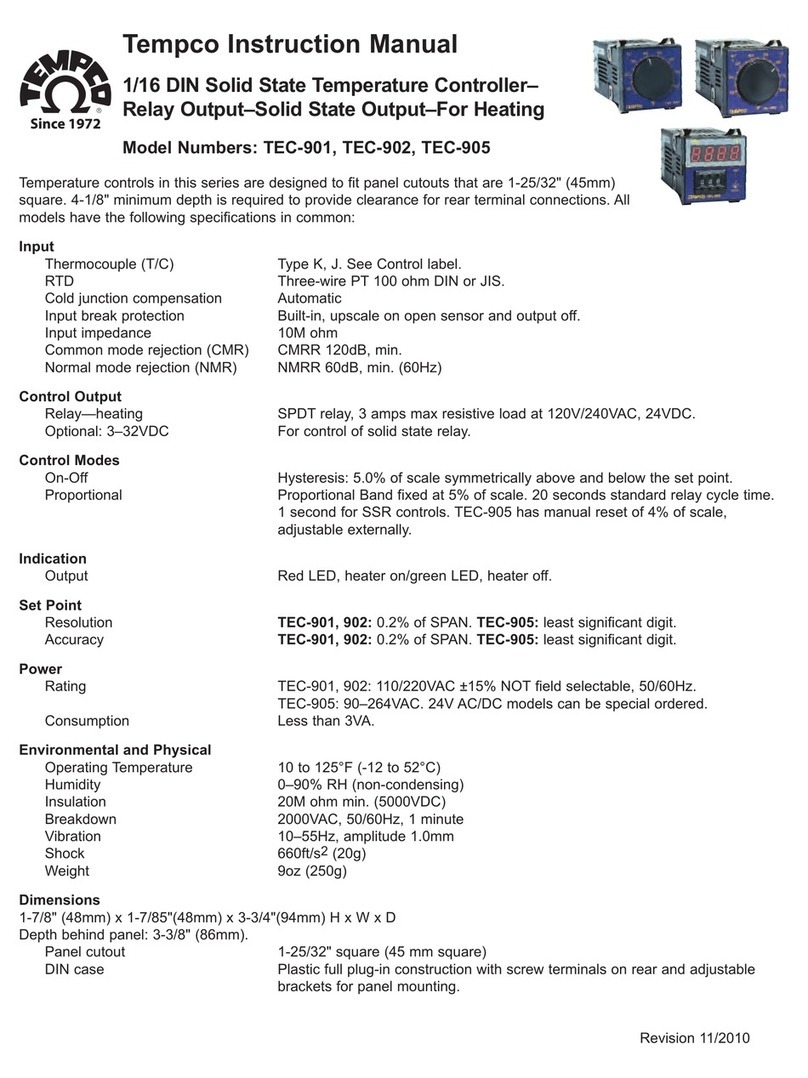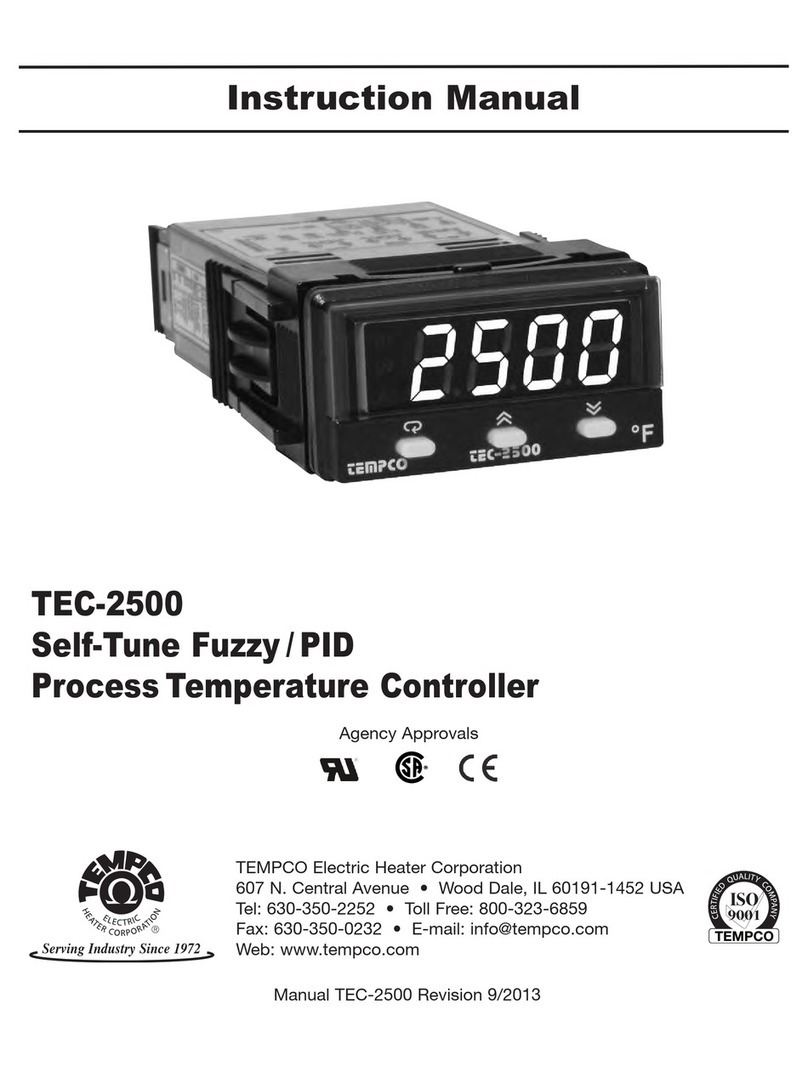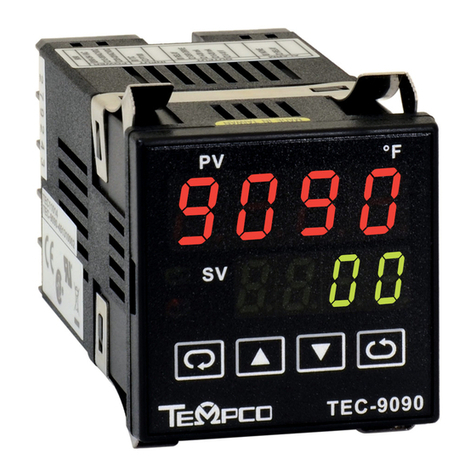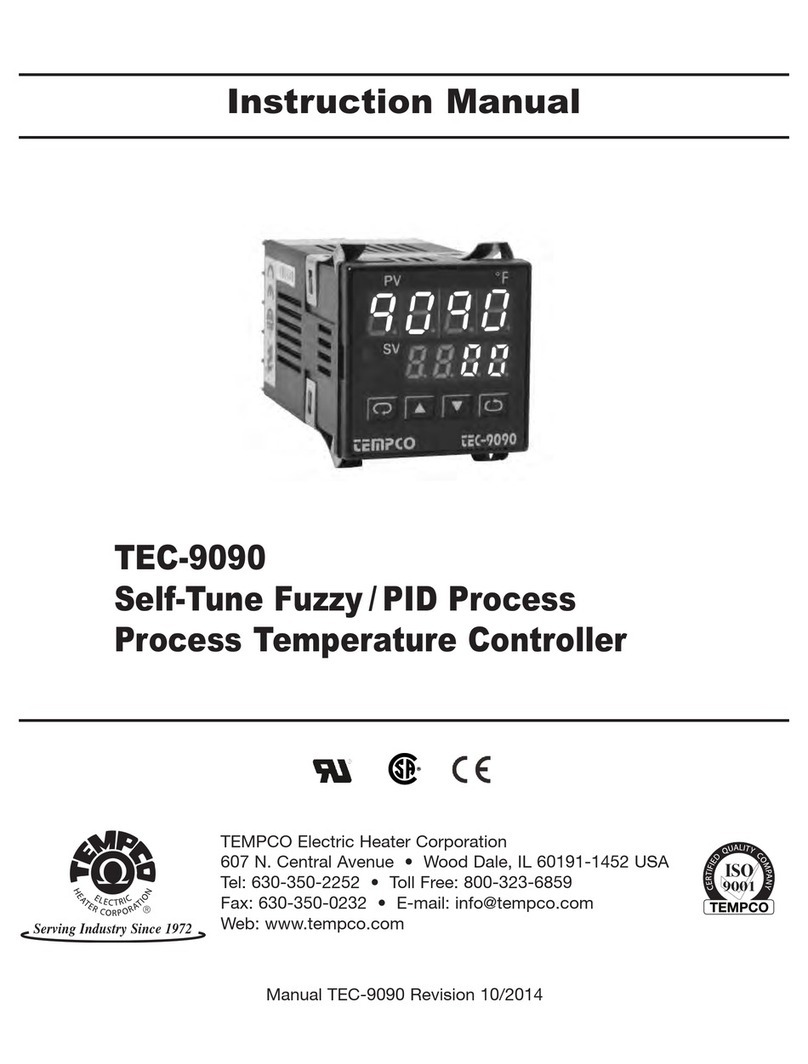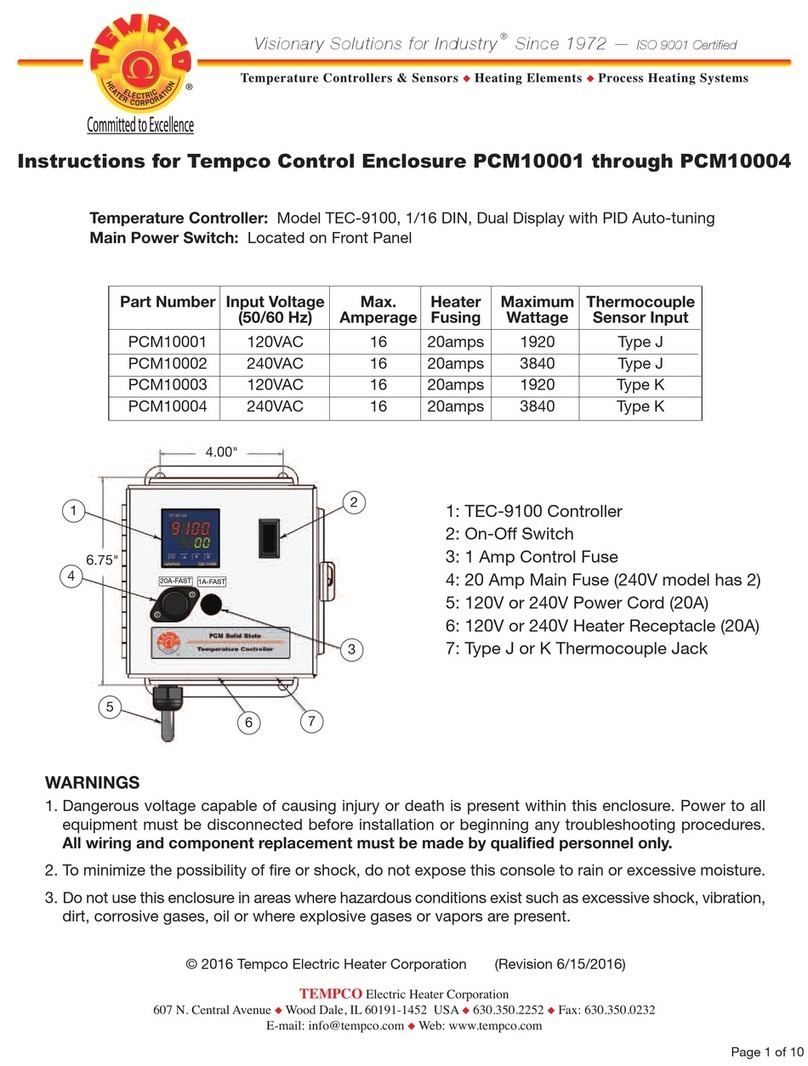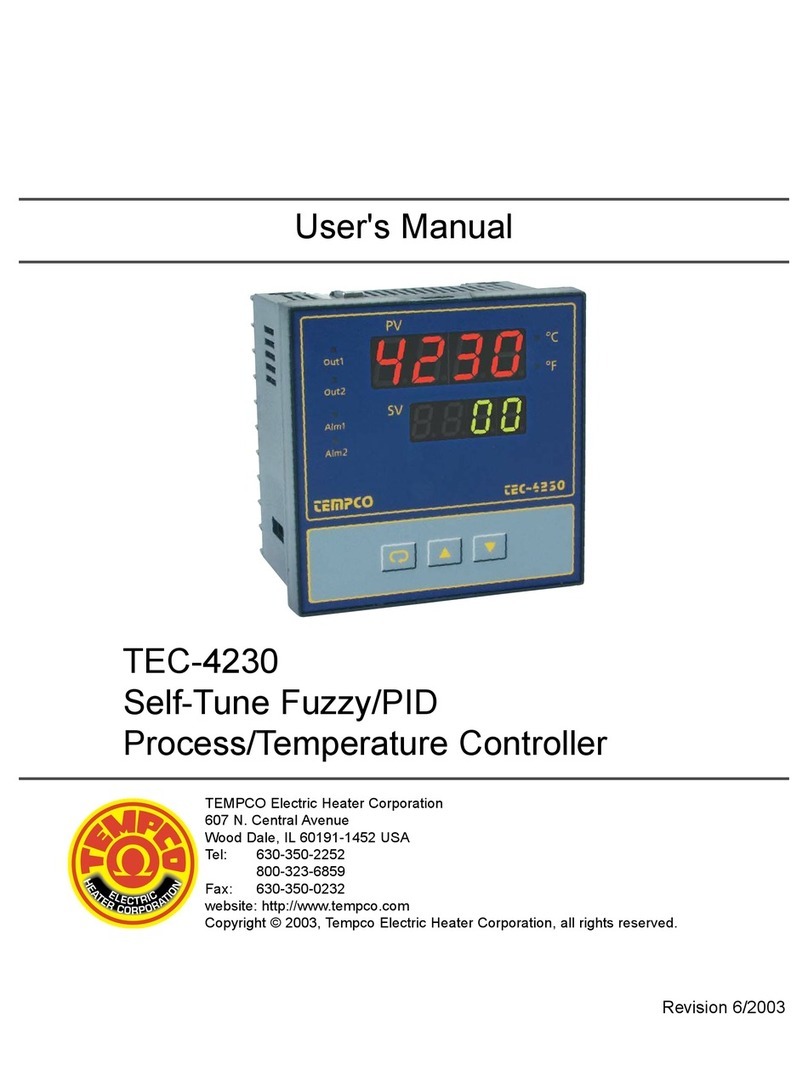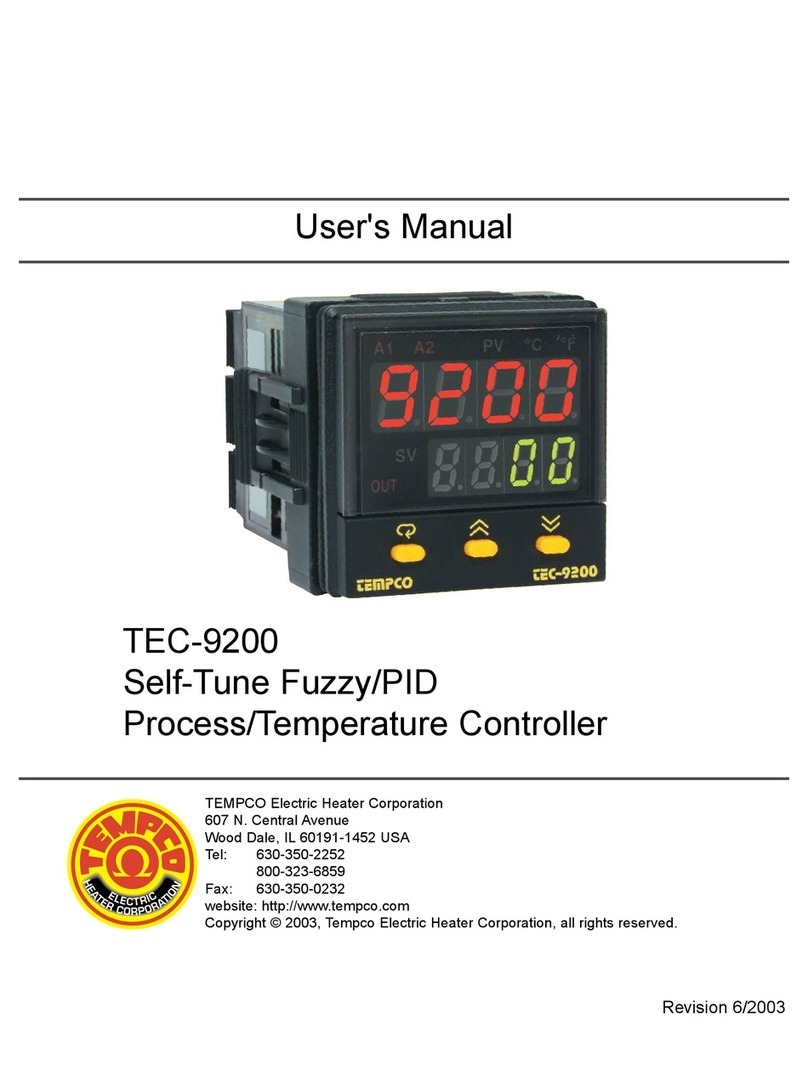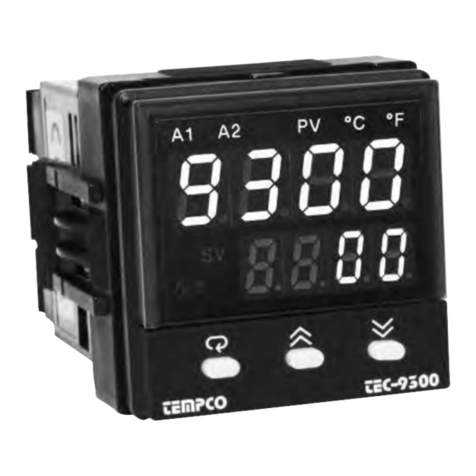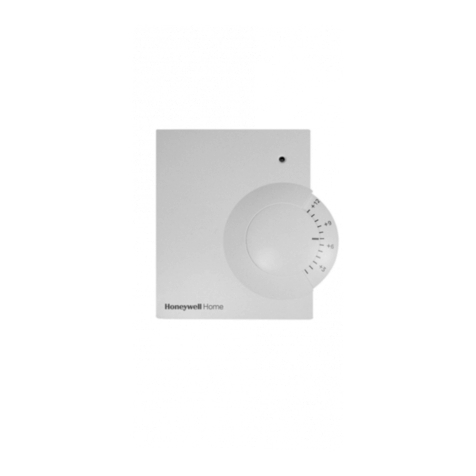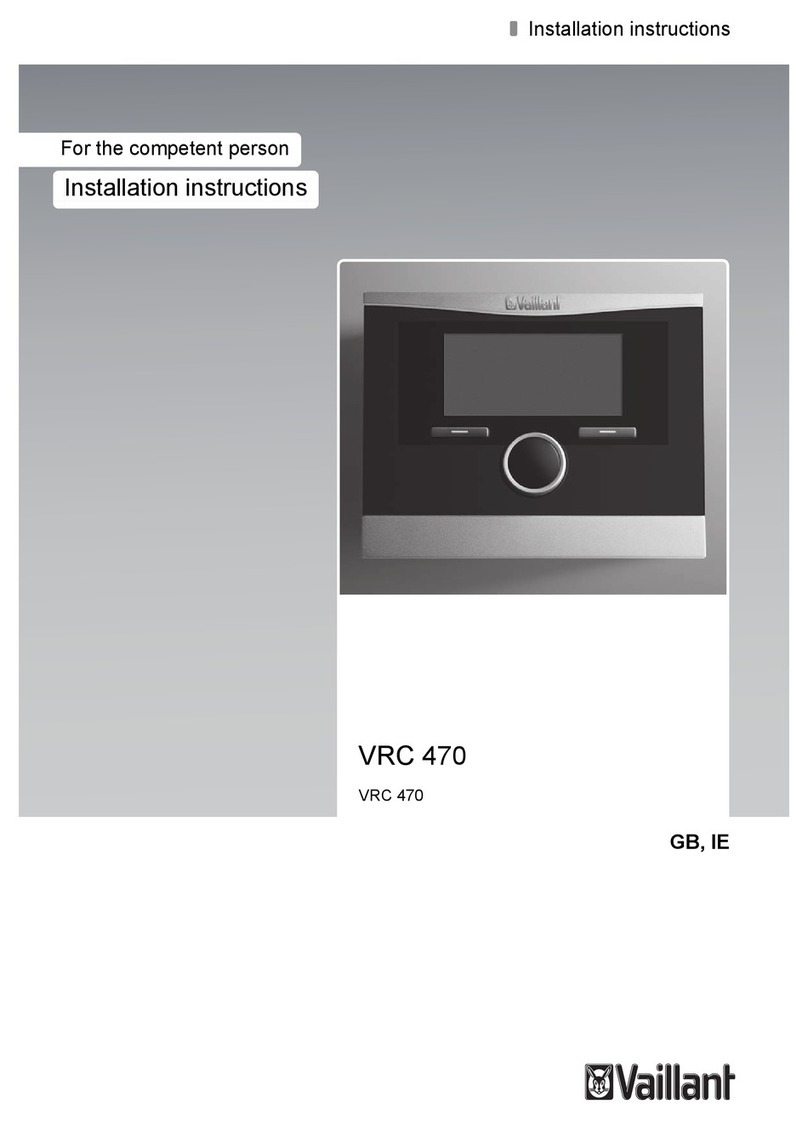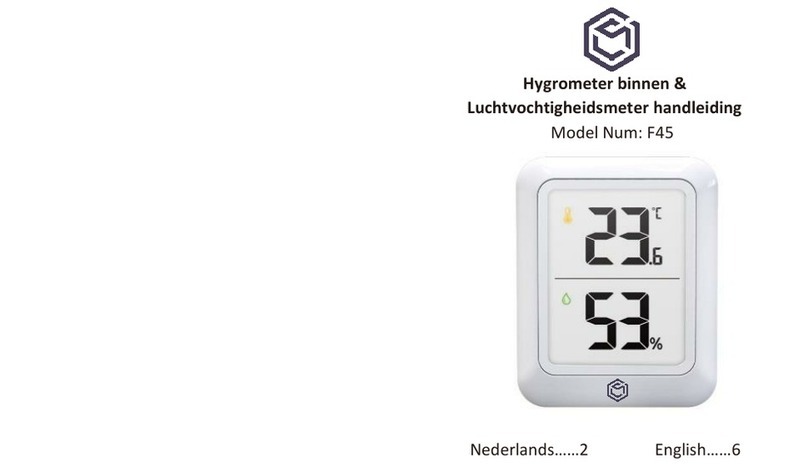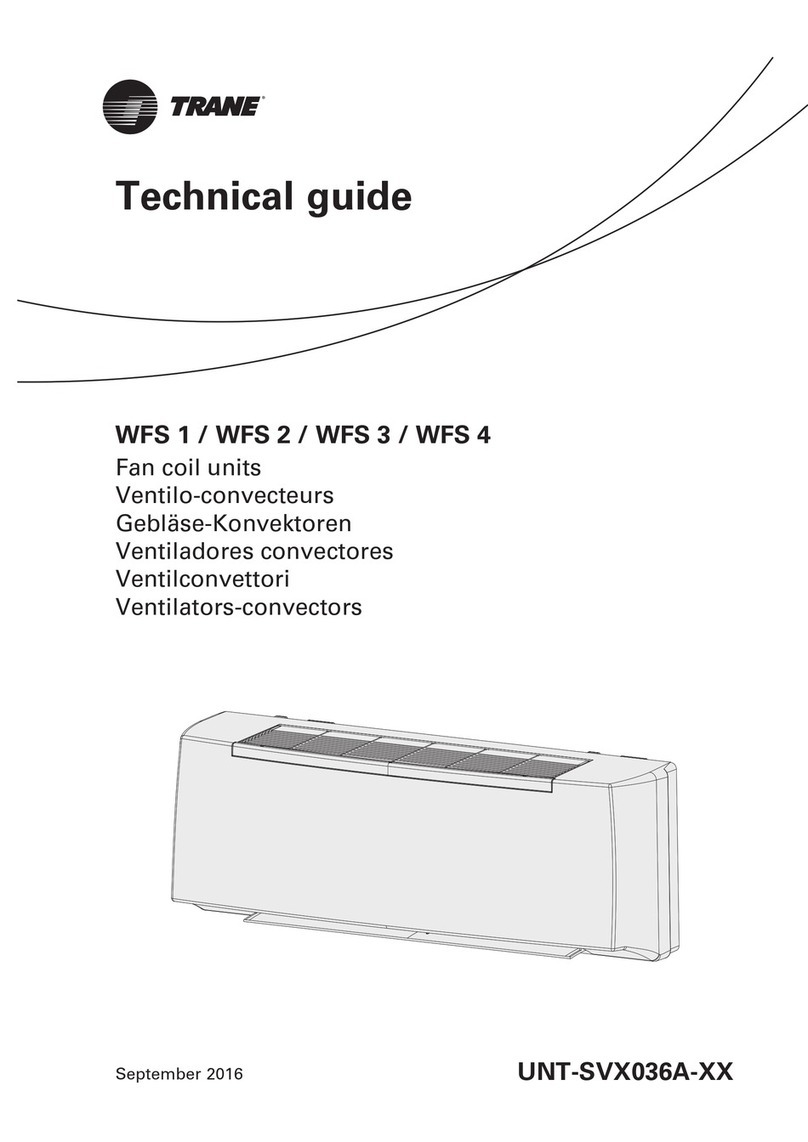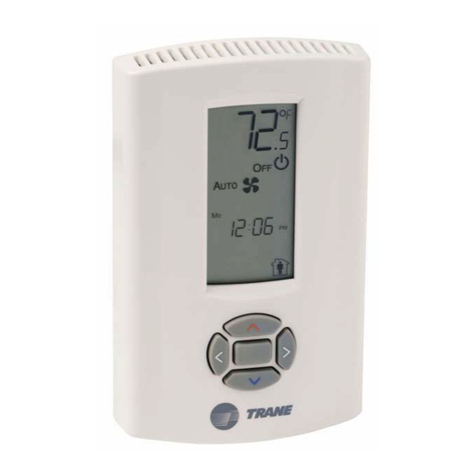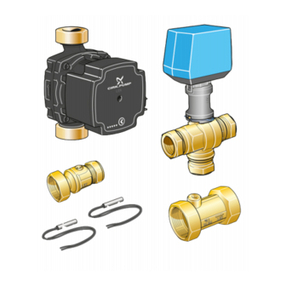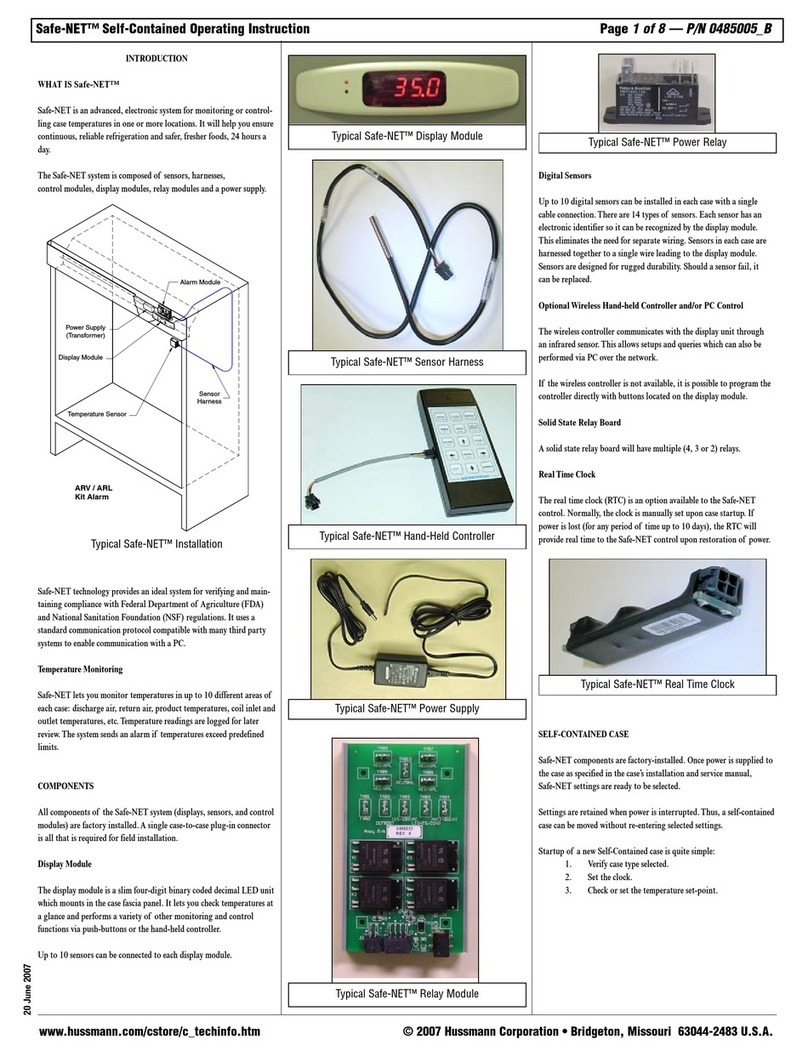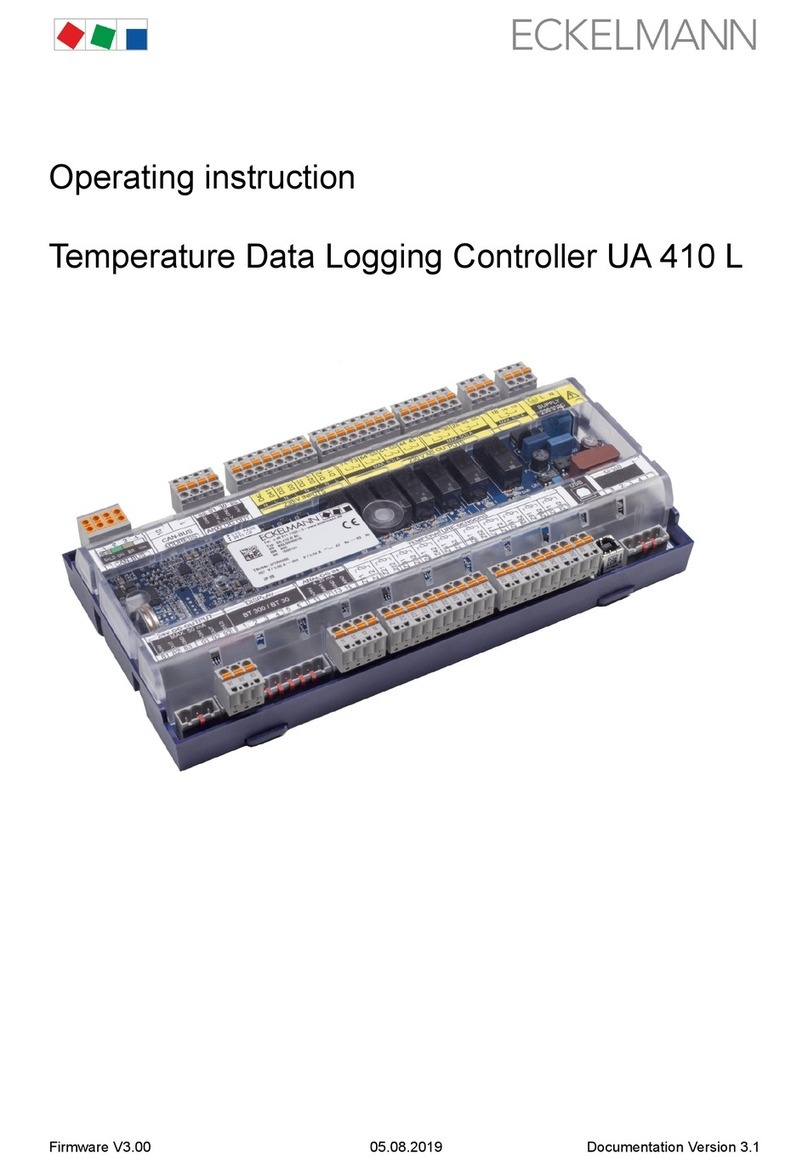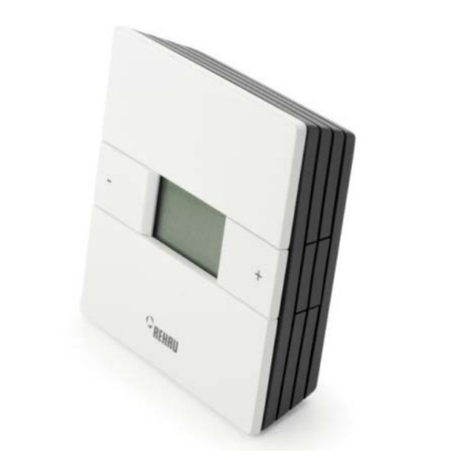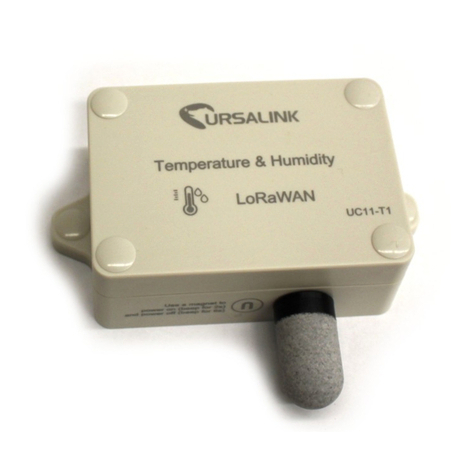Tempco tec-220 User manual

Instruction Manual
TEC-220 and TEC-920
Auto-Tune Fuzzy / PID Process
Temperature Controller
Agency Approvals
Manual EC-220/920 Revision 9/2016
EMPCO Electric Heater Corporation
607 N. Central Avenue • Wood Dale, IL 60191-1452 USA
el: 630-350-2252 • oll Free: 800-323-6859
Fax: 630-350-0232 • E-mail: [email protected]
Web: www.tempco.com
Serving Industry Since 1972

OTES

Warning Symbol
This symbol calls attention to an operating procedure, practice, or
the like which, if not correctly performed or adhered to, could
result in personal injury or damage to or destruction of part or all
of the product and system. Do not proceed beyond a warning sym-
bol until the indicated conditions are fully understood and met.
Using the Manual
Installers . . . . . . . . . . . . . . . . . . . . . . . . . . . Read Chapter 1, 2
System Designer . . . . . . . . . . . . . . . . . . . . . Read All Chapters
Expert User . . . . . . . . . . . . . . . . . . . . . . . . . Read Page 11
N TE:
It is strongly recommended that a process should incorpo-
rate a LIMIT CONTROL like TEC-910 which will shut
down the equipment at a preset process condition in order to
preclude possible damage to products or system.
Information in this user's manual is subject to change without
notice.
Copyright © 2010, Tempco Electric Heater Corporation, all
rights reserved. No part of this publication may be reproduced,
transmitted, transcribed or stored in a retrieval system, or trans-
lated into any language in any form by any means without the
written permission of Tempco Electric Heater Corporation.
Contents
age No.
Chapter 1 verview
1-1 General . . . . . . . . . . . . . . . . . . . . . . . . . . . . . . . . . . . . . 1
1-2 Ordering Code . . . . . . . . . . . . . . . . . . . . . . . . . . . . . . . 2
1-3 Programming Port . . . . . . . . . . . . . . . . . . . . . . . . . . . . 2
1-4 Keys and Displays . . . . . . . . . . . . . . . . . . . . . . . . . . . . 3
1-5 Menu Overview . . . . . . . . . . . . . . . . . . . . . . . . . . . . . . 4
1-6 Parameter Descriptions . . . . . . . . . . . . . . . . . . . . . . . . . 5
Chapter 2 Installation
2-1 Unpacking . . . . . . . . . . . . . . . . . . . . . . . . . . . . . . . . . . . 7
2-2 Mounting . . . . . . . . . . . . . . . . . . . . . . . . . . . . . . . . . . . 7
2-3 Wiring Precautions . . . . . . . . . . . . . . . . . . . . . . . . . . . . 7
2-4 Power Wiring . . . . . . . . . . . . . . . . . . . . . . . . . . . . . . . . 8
2-5 Sensor Installation Guidelines . . . . . . . . . . . . . . . . . . . 8
2-6 Sensor Input Wiring . . . . . . . . . . . . . . . . . . . . . . . . . . . 8
2-7 Control Output Wiring . . . . . . . . . . . . . . . . . . . . . . . . . 8
2-8 Alarm Wiring . . . . . . . . . . . . . . . . . . . . . . . . . . . . . . . . 10
2-9 Data Communication . . . . . . . . . . . . . . . . . . . . . . . . . . 10
Chapter 3 Programming
3-1 Lockout . . . . . . . . . . . . . . . . . . . . . . . . . . . . . . . . . . . . 11
3-2 Signal Input . . . . . . . . . . . . . . . . . . . . . . . . . . . . . . . . . 11
3-3 Control Outputs . . . . . . . . . . . . . . . . . . . . . . . . . . . . . . 11
3-4 Alarm . . . . . . . . . . . . . . . . . . . . . . . . . . . . . . . . . . . . . . 13
3-5 Configuring the Display . . . . . . . . . . . . . . . . . . . . . . . 14
3-6 Ramp . . . . . . . . . . . . . . . . . . . . . . . . . . . . . . . . . . . . . . 14
3-7 Dwell Timer . . . . . . . . . . . . . . . . . . . . . . . . . . . . . . . . . 14
3-8 PV Shift . . . . . . . . . . . . . . . . . . . . . . . . . . . . . . . . . . . . 15
3-9 Digital ilter . . . . . . . . . . . . . . . . . . . . . . . . . . . . . . . . 15
3-10 ailure Transfer . . . . . . . . . . . . . . . . . . . . . . . . . . . . . 15
3-11 Auto-tuning . . . . . . . . . . . . . . . . . . . . . . . . . . . . . . . . 16
3-12 Manual tuning . . . . . . . . . . . . . . . . . . . . . . . . . . . . . . 16
3-13 Manual Control . . . . . . . . . . . . . . . . . . . . . . . . . . . . . 17
3-14 Data communication. . . . . . . . . . . . . . . . . . . . . . . . . . 17
3-15 Process Variable (PV) Retransmission. . . . . . . . . . . . 17
Chapter 4 Applications
4-1 Heat Only Control With Dwell Timer . . . . . . . . . . . . . 19
4-2 Cool Only Control . . . . . . . . . . . . . . . . . . . . . . . . . . . . 19
4-3 Heat-Cool Control . . . . . . . . . . . . . . . . . . . . . . . . . . . . 20
Chapter 5 Calibration . . . . . . . . . . . . . . . . . . 21
Chapter 6 Specifications . . . . . . . . . . . . . 23
Chapter 7 Modbus Communications
7-1 unctions Supported . . . . . . . . . . . . . . . . . . . . . . . . . . 25
7-2 Exception Responses . . . . . . . . . . . . . . . . . . . . . . . . . . 26
7-3 Parameter Table . . . . . . . . . . . . . . . . . . . . . . . . . . . . . . 26
7-4 Data Conversion . . . . . . . . . . . . . . . . . . . . . . . . . . . . . . 28
7-5 Communication Examples . . . . . . . . . . . . . . . . . . . . . . 29
Appendix
A-1 Error Codes . . . . . . . . . . . . . . . . . . . . . . . . . . . . . . . . . 30
A-2 Warranty . . . . . . . . . . . . . . . . . . . . . . . . . . . . . . . . . . . 31
Figures & Tables
age No.
igure 1.1 uzzy Control Advantage. . . . . . . . . . . . . . . . . . 1
igure 1.2 Programming Port Overview . . . . . . . . . . . . . . . 2
igure 1.3 ront Panel Description . . . . . . . . . . . . . . . . . . 3
igure 1.4 Display in Initial Stage. . . . . . . . . . . . . . . . . . . . 3
igure 2.1 Mounting Dimensions and Panel Cutout . . . . . . 7
igure 2.2 Lead Termination for TEC-920 . . . . . . . . . . . . . 7
igure 2.3 Lead Termination for TEC-220 . . . . . . . . . . . . . 7
igure 2.4 Rear Terminal Connection for TEC-220 . . . . . . 8
igure 2.5 Rear Terminal Connection for TEC-920 . . . . . . 8
igure 2.6 Power Supply Connections . . . . . . . . . . . . . . . . 8
igure 2.7 Sensor Input Wiring . . . . . . . . . . . . . . . . . . . . . 8
igure 2.8 Output 1 Relay or Triac (SSR) to
Drive Load . . . . . . . . . . . . . . . . . . . . . . . . . . . . 8
igure 2.9 Output 1 Relay or Triac (SSR) to
Drive Contactor . . . . . . . . . . . . . . . . . . . . . . . . . 8
igure 2.10 Output 1 Pulsed Voltage to Drive SSR . . . . . . 9
igure 2.11 Output 1 Linear Current. . . . . . . . . . . . . . . . . . 9
igure 2.12 Output 1 Linear Voltage. . . . . . . . . . . . . . . . . . 9
igure 2.13 Output 2 Relay or Triac (SSR) to
Drive Load . . . . . . . . . . . . . . . . . . . . . . . . . . . . 9
igure 2.14 Output 2 Relay or Triac (SSR) to
Drive Contactor . . . . . . . . . . . . . . . . . . . . . . . . 9
igure 2.15 Output 2 Pulsed Voltage to Drive SSR . . . . . . 9
igure 2.16 Output 2 Linear Current. . . . . . . . . . . . . . . . . . 9
igure 2.17 Output 2 Linear Voltage . . . . . . . . . . . . . . . . . 9
igure 2.18 Alarm Output to Drive Load . . . . . . . . . . . . . 10
igure 2.19 Alarm Output to Drive Contactor . . . . . . . . . . 10
igure 2.20 RS-485 Wiring . . . . . . . . . . . . . . . . . . . . . . . . 10
igure 2.21 RS-232 Wiring . . . . . . . . . . . . . . . . . . . . . . . . 10
igure 2.22 Configuration of RS-232 Cable . . . . . . . . . . . 10
igure 3.1 Conversion Curve for Linear Type
Process Value . . . . . . . . . . . . . . . . . . . . . . . . . . 11
igure 3.2 Heat Only ON-O Control . . . . . . . . . . . . . . . 12
igure 3.3 Output 2 Deviation High Alarm . . . . . . . . . . . . 13
igure 3.4 Output 2 Process Low Alarm . . . . . . . . . . . . . . 13
igure 3.5 RAMP unction . . . . . . . . . . . . . . . . . . . . . . . . 14
igure 3.6 Dwell Timer unction . . . . . . . . . . . . . . . . . . . . 14
igure 3.7 PV Shift Application . . . . . . . . . . . . . . . . . . . . . 15
igure 3.8 ilter Characteristics . . . . . . . . . . . . . . . . . . . . . 15
igure 3.9 Effects of PID Adjustment . . . . . . . . . . . . . . . . 16
igure 4.1 Heat Control Example. . . . . . . . . . . . . . . . . . . . 19
igure 4.2 Cooling Control Example . . . . . . . . . . . . . . . . . 19
igure 4.3 Heat-Cool Control Example . . . . . . . . . . . . . . . 20
igure 5.1 RTD Calibration . . . . . . . . . . . . . . . . . . . . . . . . 21
igure 5.2 Cold Junction Calibration Setup . . . . . . . . . . . . 22
Table 1.1 Display orm of Characters . . . . . . . . . . . . . . . . 3
Table 3.1 Heat-Cool Control Setup Value . . . . . . . . . . . . . 11
Table 3.2 PID Adjustment Guide . . . . . . . . . . . . . . . . . . . . 16
Table A.1 Error Codes and Corrective Actions . . . . . . . . . 30
Appendix
Warranty . . . . . . . . . . . . . . . . . . . . . . . . . . . . . . . . . . . . . . . 31
Returns . . . . . . . . . . . . . . . . . . . . . . . . . . . . . . . . . . . . . . . . 31

OTES

1–1 General
Tempco’s TEC-220 and TEC-920 uzzy Logic plus PID micro-
processor-based controllers incorporate a bright easy to read 4-
digit LED display indicating process value or set point. uzzy
Logic technology enables a process to reach a predetermined set
point in the shortest time with a minimum of overshoot during
power-up or external load disturbances.
The TEC-220 is a 1/32 DIN size panel mount controller. The
TEC-920 is a 1/16 DIN size panel mount controller. These units
are powered by 11–26 or 90–250 VDC/VAC 50/60 Hz supply,
incorporating a 2 Amp control relay output as a standard. The
second output can be used as a cooling control, an alarm or a
dwell timer. Either output can use a triac, 5V logic output, linear
current or linear voltage to drive an external device. There are six
types of alarms or a dwell timer that can be configured for the
second output. The units are fully programmable for PT100 RTD
and thermocouple types J, K, T, E, B, R, S, N, and L with no need
to modify the unit. The input signal is digitized by using an 18-
bit A to D converter. Its fast sampling rate allows the unit to con-
trol fast processes.
Digital communications RS-485 is available for the TEC-220 or
TEC-920. RS-232 is available for the TEC-220 only. These
options allow the units to be integrated with supervisory control
systems and software.
A programming port is available for automatic configuration,
without the need to access the keys on the front panel.
By using proprietary uzzy modified PID technology, the con-
trol loop will minimize overshoot and undershoot in a short time.
The following diagram is a comparison of results with and with-
out uzzy technology.
1
Chapter 1 verview
High accuracy
This series is manufactured with custom
designed ASIC (Application Specific
Integrated Circuit) technology which
contains an 18-bit A to D converter for
high resolution measurement (true 0.1°
resolution for thermocouple and RTD)
and a 15-bit D to A converter for linear
current or voltage control output. The
ASIC technology provides improved
operating performance, low cost,
enhanced reliability, and higher density.
Fast sampling rate
The sampling rate of the input A to D
converter is 5 times/second. The fast
sampling rate allows this series to control
fast processes.
Fuzzy control
The function of uzzy control is to adjust
PID parameters from time to time in
order to make manipulation of the output
value more flexible and adaptive to vari-
ous processes. The result is to enable a
process to reach a predetermined set
point in the shortest time with the mini-
mum of overshoot and undershoot during
power-up or external load disturbance.
Digital communication
The units are equipped with an optional
RS-485 or RS-232 interface cards to pro-
vide digital communication. By using the
twisted pair wires up to 247 units can be
connected together via RS-485 interface
to a host computer.
Programming port
A programming port can be used to con-
nect the unit to a PC for quick configura-
tion.
Auto-tune
The auto-tune function allows the user to
simplify initial setup for a new system.
An advanced algorithm is used to obtain
an optimal set of control parameters for
the process, and it can be applied either as
the process is warming up (cold start) or
when the process is in a steady state
(warm start).
Lockout protection
Depending on security requirements, one
of four lockout levels can be selected to
prevent the unit from being changed
without permission.
Bumpless transfer
Bumpless transfer allows the controller to
continue to control if the sensor breaks by
using its previous value. Hence, the
process can be controlled temporarily as
if the sensor reading is normal and con-
stant.
Soft-start ramp
The ramping function is performed dur-
ing power up as well as any time the set
point is changed. It can be ramping up or
ramping down. The process value will
reach the set point at a predetermined
constant rate.
Digital filter
A first order low pass filter with a pro-
grammable time constant is used to
improve the stability of the process value.
This is particularly useful in certain
applications where the process value is
too unstable to be read.

2
1–2 rdering Code
1–3 Programming Port
A special connector can be used to
connect the programming port to a PC
for automatic configuration.
The programming port is used for off-
line automatic setup and testing proce-
dures only. Don't attempt to make any
connection to these pins when the unit
is under power.
Figure 1.2
Programming Port Overview

3
1–4 Keys and Displays
KEYPAD OPERATIO
SCROLL KEY:
This key is used to select a parameter to be
viewed or adjusted.
UP KEY:
This key is used to increase the value of the
selected parameter.
DOW KEY:
This key is used to decrease the value of the
selected parameter.
RESET KEY: for TEC-920,
for TEC-220
This key is used to:
1. Revert the display to show the process value.
2. Reset the latching alarm, once the alarm condi-
tion is removed.
3. Stop the manual control mode, auto-tuning
mode, and calibration mode.
4. Clear the message of communication error and
auto-tuning error.
5. Restart the dwell timer when the dwell timer has
timed out.
6. Enter the manual control menu when in failure
mode.
E TER KEY: Press for 5 seconds or longer.
Press for 5 seconds to:
1. Enter setup menu. The display shows .
2. Enter manual control mode — when manual
control mode or is selected.
3. Enter auto-tuning mode — when auto-tuning
mode (for 220) or AT (for 920) is selected.
4. Perform calibration to a selected parameter dur-
ing the calibration procedure.
Press for 6.2 seconds to select calibration mode.
R
Displays program code of the
instrument for 2.5 seconds.
The diagram at left shows
program no. 34, version 16
for the TEC-920.
The program no. is 33 for the
TEC-220.
Figure 1.3
Front Panel Description
Figure 1.4
Display in Initial Stage
Table 1.1 Display Form of Characters

4
1–5 Menu verview

5
1–6 Parameter Descriptions

6
1–6 Parameter Descriptions, continued…

Dangerous voltages capable of causing death are some-
times present in this instrument. Before installation or
beginning any troubleshooting procedures, the power to all
equipment must be switched off and isolated. Units suspected of
being faulty must be disconnected and removed to a properly
equipped workshop for testing and repair. Component replace-
ment and internal adjustments must be made by a qualified main-
tenance person only.
This instrument is protected by double insulation. To
minimize the possibility of fire or shock hazards do not
expose this instrument to rain or excessive moisture.
Do not use this instrument in areas under hazardous con-
ditions such as excessive shock, vibration, dirt, moisture,
corrosive gases or oil. The ambient temperature of the area
should not exceed the maximum rating specified in chapter 6.
Remove stains from this instrument using a soft, dry
cloth. To avoid deformation or discoloration do not use
harsh chemicals, volatile solvent such as thinner or strong deter-
gents to clean this instrument.
2–1 Unpacking
Upon receipt of the shipment, remove the unit from the carton
and inspect the unit for shipping damage.
2–2 Mounting
Make the panel cutout according to the dimensions shown in
igure 2.1.
Take the mounting clamp away and insert the controller into the
panel cutout. Reinstall the mounting clamp.
7
Chapter 2 Installation
Wiring, continued…
Transit Damage
If there is any damage due to transit, report it and
file a claim with the carrier. Write down the model
number, serial number, and date code for future ref-
erence when corresponding with our service center.
The serial number (S/N) is labeled on the box and
the housing of the control.
2–3 Wiring Precautions
• Before wiring, verify the correct model number and options on the label.
Switch off the power while checking.
• Care must be taken to ensure that the maximum voltage rating specified on
the label is not exceeded.
• It is recommended that the power for these units be protected by fuses or cir-
cuit breakers rated at the minimum value possible.
• All units should be installed in a suitable enclosure to prevent live parts from
being accessible to human hands and metal tools. Metal enclosures and/or
subpanels should be grounded in accordance with national and local codes.
• All wiring must conform to appropriate standards of good practice and local
codes and regulations. Wiring must be suitable for the voltage, current, and
temperature rating of the system.
• Beware not to over-tighten the terminal screws. The torque should not
exceed 1 N-m (8.9 lb-in or 10 Kg -cm).
• Unused control terminals should not be used as jumper points as they may
be internally connected, causing damage to the unit.
• Verify that the ratings of the output devices and the inputs as specified are
not exceeded.
• Except for thermocouple wiring, all wiring should use stranded copper con-
ductor with a maximum gage of 14 AWG.
• Electrical power in industrial environments contains a certain amount of
noise in the form of transient voltage and spikes. This electrical noise can
adversely affect the operation of microprocessor-based controls. or this
reason the use of shielded thermocouple extension wire which connects the
sensor to the controller is strongly recommended. This wire is a twisted-pair
construction with foil wrap and drain wire. The drain wire is to be attached
to ground in the control panel only.
Note: All model TEC-220 controls are supplied with
both mounting clamps and mounting screws. The
mounting screws have to be used in NEMA 4X appli-
cations as they allow the control to be held tighter
into the panel. The mounting clamp teeth are released
by depressing the ends of the clamp together.

8
2–4 Power Wiring
The controller is designed to operate at 11–26VAC/VDC
or 90–250VAC. Check that the input voltage corresponds
to the power rating indicated on the product label before
connecting power to the controller.
2–5 Sensor Installation Guidelines
Proper sensor installation can eliminate many problems in a con-
trol system. The probe should be placed so that it can detect any
temperature change with minimal thermal lag. In a process that
requires fairly constant heat output, the probe should be placed
close to the heater. In a process where the heat demand is variable,
the probe should be close to the work area. Some experimentation
with probe location is often required to find the optimum position.
In a liquid process, the addition of a stirrer will help to eliminate
thermal lag. Since the thermocouple is basically a point measur-
ing device, placing more than one thermocouple in parallel can
provide an average temperature readout and produce better
results in most air heated processes. Proper sensor type is also a
very important factor in obtaining precise measurements. The
sensor must have the correct temperature range to meet the
process requirements. In special processes, the sensor might have
requirements such as leak-proof, anti-vibration, antiseptic, etc.
Standard sensor limits of error are ±4° (±2°C) or 0.75% of the
sensed temperature (half that for special) plus drift caused by
improper protection or an over-temperature occurrence. This
error is far greater than controller error and cannot be corrected
on the sensor except by proper selection and replacement.
2–6 Sensor Input Wiring
2–7 Control utput Wiring
This equipment is designed for installation in an
enclosure which provides adequate protection against
electric shock. Metal enclosures must be connected to
earth ground.
Local requirements regarding electrical installation should be
rigidly observed. Consideration should be given to prevent
unauthorized personnel from accessing the power terminals.
Wiring, continued…

9
Control utput Wiring, continued…
Load
120V / 240V
Mains Supply
SSR
30mA/5V
Pulsed
Voltage
Internal Circuit
+
5V
0V
33
33
_
+
+
_
5
6
10
9
TEC
220
TEC
920
Figure 2.10 Output 1 Pulsed
Voltage to Drive SSR
_
+

10
If you use a conventional 9-pin RS-232 cable instead
of TEC99014, the cable must be modified according
to the following circuit diagram.
2–9 Data Communication
2–8 Alarm Wiring

11
Chapter 3 Programming
Press for 5 seconds and release to enter the setup menu.
Press and release to select the desired parameter. The display
indicates the parameter symbol. Press or to view or
adjust the value of the selected parameter.
3–1 Lockout
There are four security levels that can be selected using the
LOCK parameter.
If NONE is selected for LOCK, then no parameter is locked.
If SET is selected for LOCK, then all setup data are locked.
If USER is selected for LOCK, then all setup data as well as
user data (refer to section 1-5) except the set point are
locked to prevent them from being changed.
If ALL is selected for LOCK, then all parameters are locked to
prevent them from being changed.
How to use Conversion Curve for
Process Value:
If 4–20mA is selected for INPT, SL specifies the input signal low
(i.e., 4mA), SH specifies the input signal high (i.e., 20mA), S
specifies the current input signal value, and the conversion curve
of the process value is shown as follows:
3–2 Signal Input
IN T: Selects the sensor type or signal type for signal input.
Range: (thermocouple) Type J, K, T, E, B, R, S, N, L
(RTD) PT.DN, PT.JS
(Linear) 4–20 mA, 0–20 mA, 0–60 mA, 0–1V,
0–5V, 1–5V, 0–10V
UNIT: Selects the process unit
Range: °C, ° , PU (process unit). If the unit is set for
neither °C nor ° , then it defaults to PU.
D : Selects the resolution of process value.
Range: ( or T/C and RTD) NO.DP, 1-DP
( or linear) NO.DP, 1-DP, 2-DP, 3-DP
INLO: Selects the low scale value for the linear type input.
INHI: Selects the high scale value for the linear type input.
3–3 Control utputs
There are four kinds of control modes that can be configured as shown in table 3.1.
SL = Setpoint Low Limit SH = Setpoint High Limit

12
Heat only ON-OFF control: Select REVR for OUT1. Set PB
(Proportional Band) to 0. O1HY is used to adjust dead band for
ON-O control. The output 1 hysteresis (O1HY) is enabled
when PB=0. The heat only on-off control function is shown in the
following diagram:
The ON-O control may introduce excessive process oscillation
even if hysteresis is minimized. If ON-O control is set (i.e.,
PB=0), TI, TD, CYC1, O ST, CYC2, CPB, and DB will be hid-
den and have no function in the system. The auto-tuning and
bumpless transfer function will be disabled as well.
Heat only (or D) control: Select H.TPC or H.L I N for OUT1
and set TI1 and TI2 to 0, O ST is used to adjust the control offset
(manual reset). O1HY is hidden if PB is not equal to 0.
OFST function: OFST is measured in % wit a range of 0–
100.0%.
In a steady state (i.e. process as stabilized at a temperature), if
t e process value is lower t an t e set point by a constant value
(we’ll say 5°C) w ile t e PB setting is set for 20°C, we can say
t e temperature is lower t an t e setpoint by 25% of t e PB set-
ting. T is can be corrected by increasing t e OFST setting to
25%. After adjusting t e OFST value, t e process value will
eventually coincide wit set point.
Note t at using t e P control (TI set to 0), disables auto-tuning.
Refer to Section 3-12 “manual tuning” for t e adjustment of P
and PD. Manual reset (adjust OFST) is sometimes not practical
since t e load may c ange from time to time and OFST may need
to be adjusted repeatedly. PID control can avoid t is situation.
Heat only ID control: If REVR is selected for OUT1, PB and
TI should not be zero. Perform auto-tuning for the new process,
or set PB, TI, and TD with historical values. See section 3-11 for
auto-tuning operation. If the control result is still unsatisfactory,
then use manual tuning to improve control. See section 3-12 for
manual tuning. The unit contains an advanced PID and uzzy
algorithm to create a small overshoot and very quick response to
the process if it is properly tuned.
Control utputs, continued…
Cool only control: ON-O control, P (PD) control, and PID
control can be used for cool control. Set OUT1 to DIRT (direct
action). The other functions for cool only ON-O control, cool
only P (PD) control, and cool only PID control are the same as for
heat only control except that the output variable (and action) for
cool control is inverse to heat control.
NOTE: ON-O control may result in excessive overshoot and
undershoot problems in the process. P (or PD) control will result
in a deviation of process value from the set point. It is recom-
mended to use PID control for heat-cool control to produce a sta-
ble and zero offset process value.
Other setup required: O1TY, CYC1, O2TY, CYC2, O1 T and
O2 T are set in accordance with the types of OUT1 and OUT2
installed. CYC1 and CYC2 are selected according to the output 1
type (O1TY) and output 2 type (O2TY). Generally, select 0.5~2
seconds for CYC1 if SSRD or SSR is used for O1TY; 10~20 sec-
onds if relay is used for O1TY and CYC1 is ignored if linear out-
put is used. Similar conditions are applied for CYC2 selection.
You can use the auto-tuning program for the new process or
directly set the appropriate values for PB, TI, and TD according
to historical records for duplicate systems. If the control behavior
is still inadequate, then use manual tuning to improve the control.
See section 3-12 for manual tuning.
C B (Cooling roportional Band) rogramming: The cooling
proportional band is measured by % of PB with a range of
50-300. Initially set 100% for CPB and examine the cooling
effect. If the cooling action should be enhanced, then decrease
CPB, if the cooling action is too strong, then increase CPB. The
value of CPB is related to PB and its value remains unchanged
throughout the auto-tuning procedures.
Adjustment of CPB is related to the cooling medium used. If air
is used as the cooling medium, initially set CPB to 100%, then
adjust as necessary. If oil is used as the cooling medium, initially
set CPB to 125%, then adjust as necessary. If water is used as the
cooling medium, initially set CPB to 250%, then adjust as necessary.
DB (Heating-Cooling Dead Band) programming: The adjust-
ment of DB is dependent on the system requirements. If a more
positive value of DB (greater dead band) is used, an unwanted
cooling action can be avoided but an excessive overshoot over the
set point will occur. If a more negative value of DB (greater over-
lap) is used, an excessive overshoot over the set point can be min-
imized, but an unwanted cooling action will occur. It is adjustable
in the range -36.0% to 36.0% of PB. A negative DB value shows
an overlap area over which both outputs are active. A positive DB
value shows a dead band area over which neither output is active.
Output 2 ON-OFF control (alarm function): Output 2 can also
be configured with an alarm function. There are six kinds of
alarm functions that can be selected for output 2. These are:
DE.HI (deviation high alarm), DE.LO (deviation low alarm),
DB.HI (deviation band out of band alarm), DB.LO (deviation
band in band alarm), V.HI (process high alarm), and V.LO
(process low alarm). Refer to figure 3.3 and figure 3.4 for
descriptions of the deviation alarm and the process alarm.

13
3.3 & 3.4 Alarm Figures
3–4 Alarm
Output 2 can be set as an alarm output. There are six types of
alarm functions and one dwell timer that can be selected, and
four kinds of alarm modes (ALMD) are available for each
alarm function.
A process alarm sets two absolute trigger levels. When the
process value is higher than SP2, a process high alarm
(PV.HI) occurs. The alarm is off when the process value is
lower than SP2-ALHY. When the process value is lower than
SP2, a process low alarm (PV.LO) occurs, and the alarm is
off when the process value is higher than SP2+ALHY. A
process alarm is independent of the set point.
A deviation alarm alerts the user when the process value
deviates too far from the set point. When the process value is
higher than SV+SP2, a deviation high alarm (DE.HI) occurs,
and the alarm is off when the process value is lower than
SV+SP2-ALHY. When the process value is lower than
SV+SP2, a deviation low alarm (DE.LO) occurs, and the
alarm is off when the process value is higher than
SV+SP2+ALHY. The trigger level of the deviation alarm
moves with the set point.
A deviation band alarm presets two trigger levels relative
to the set point. The two trigger levels are SV+SP2 and SV-
SP2 for alarm. When the process value is higher than
(SV+SP2) or lower than (SV-SP2), a deviation band high
alarm (DB.HI) occurs. When the process value is within the
trigger levels, a deviation band low alarm (DB.LO) occurs.
There are four types of alarm modes available for each alarm
function. These are: normal alarm, latching alarm, holding
alarm and latching/holding alarm. They are described as fol-
lows:
ormal alarm: ALMD= ORM
When a normal alarm is selected, the alarm output is de-ener-
gized in the non-alarm condition and energized in an alarm
condition.
Latching alarm: ALMD=LTCH
If a latching alarm is selected, once the alarm output is ener-
gized, it will remain unchanged even if the alarm condition
is cleared. The latching alarm is reset when the RESET key
is pressed after the alarm condition is removed.
Holding alarm: ALMD=HOLD
A holding alarm prevents an alarm when the control is pow-
ering up. The alarm is enabled only when the process reaches
the set point value. Afterwards, the alarm performs the same
function as a normal alarm.
Latching/holding alarm: ALMD=LT.HO
A latching/holding alarm performs both holding and latching
functions. The latching alarm is reset when the RESET key
is pressed after the alarm condition is removed.
Alarm failure transfer is activated as the unit enters failure
mode. The alarm will go on if AL T is set for ON and go off
if AL T is set for O . The unit will enter failure mode when
a sensor break occurs or if the A-D converter of the unit fails.

14
3–5 Configuring the Display
The TEC-220 can be configured to display the process value by
selecting PV for DISP or to display the set point value by select-
ing SP1 for DISP.
If LOCK is set to NONE, OUT2 is set to DEHI, and DISP is set
to PV, set SEL1=SHI , SEL2=ADDR. SEL3=PB,
SEL4~SEL8=NONE, then the display scrolling for the TEC-220
will become:
If LOCK is set to NONE, OUT1 is set to REVR, a non-zero value
is set for PB and TI, OUT2 is set to COOL, and DISP is set to
SP1, set SEL1=INPT, SEL2=PB, SEL3=TI, SEL4~SEL8=
NONE, then the display scrolling for the TEC-220 will become:
Example for TEC-920:
Set OUT2=PVLO, LOCK=NONE, SEL1=INPT, SEL2=UNIT,
SEL3=DP, SEL4~SEL8=NONE, then the display scrolling for
the TEC-920 will become:
3–6 Ramp
Ramp
The ramping function is performed during power up as well as
any time the set point is changed. If MINR or HRR is chosen for
RAMP, the unit will perform the ramping function. The ramp rate
is programmed by adjusting RR. The ramping function is dis-
abled as soon as failure mode, manual control mode, auto-tuning
mode or calibration mode is entered.
Example without dwell timer
Select MINR for RAMP, select °C for UNIT, select 1-DP for DP,
set RR=10.0. SV is set to 200°C initially, and changed to 100°C
30 minutes after power-up. The starting temperature is 30°C.
After power-up, the process runs like the curve shown in
igure 3.5.
Note: When the ramp function is used, the lower display will
show the current ramping value. The ramping value is an artifi-
cially determined setpoint created and updated by the control to
match the ramp rate set by the user. However, it will revert to
show the set point value as soon as the up or down key is touched
for adjustment. The ramping value is initiated to process value
either on power-up or when RR and/or the set point are changed.
Setting RR to zero means no ramp function.
3–7 Dwell Timer
Output 2 can be configured as a dwell timer by selecting TIMR
for OUT2. As the dwell timer is configured, the parameter SP2 is
used for dwell time adjustment. The dwell time is measured in
minutes ranging from 0.1 to 4553.6 minutes. Once the process
reaches the set point the dwell timer starts to count down to zero
(time out). The timer relay will remain unchanged until time out.
The dwell timer operation is shown in the following diagram.
After time out, the dwell timer can be restarted by pressing the
RESET key.
The timer stops counting during manual control mode, failure
mode, the calibration period and the auto-tuning period.
If output 2 is configured as a dwell timer, ALMD will be hidden.

15
3–8 PV Shift
In certain applications it is desirable to shift the
controller display value from its actual value. This
can easily be accomplished by using the PV shift
function.
The SHI function will alter PV only.
Here is an Example: A process is equipped with a
heater, a sensor, and a subject to be warmed up. Due
to the design and position of the components in the
system, the sensor could not be placed any closer to
the part. Thermal gradient (differing temperatures)
is common and necessary to an extent in any ther-
mal system for heat to be transferred from one point
to another. If the difference between the sensor and
the subject is 35°C, and the desired temperature at
the subject to be heated is 200°C, the controlling
value or the temperature at the sensor should be
235°C. You should enter -35°C to subtract 35°C
from the actual process display. This in turn will
cause the controller to energize the load and bring
the process display up to the set point value.
3–9 Digital Filter
In certain applications, the process value is too unstable to be read due
to possible electrical noise. A programmable low-pass filter incorpo-
rated in the controller can be used to improve this. It is a first-order
filter with the time constant specified by the ILT parameter. The
default value of ILT is set at 0.5 seconds before shipping. Adjust
ILT to change the time constant from 0 to 60 seconds. 0 seconds
means no filter is applied to the input signal. The filter is characterized
in igure 3.8.
Note
The filter is available only for PV, and is performed for the displayed
value only. The controller is designed to use unfiltered signal for con-
trol even if the filter is applied. A lagged (filtered) signal, if used for
control, may produce an unstable process.
3–10 Failure Transfer
The controller will enter failure mode if
one of the following conditions occurs:
1. SBER occurs due to input sensor break
or input current below 1mA if 4–20 mA
is selected or input voltage below 0.25V
if 1–5V is selected.
2. ADER occurs due to the A-D converter
of the controller failing.
Output 1 and output 2 will perform the fail-
ure transfer function as the controller
enters failure mode.
Output 1 failure transfer, if activated,
will perform:
1. If output 1 is configured as proportional
control (PB≠ 0), and BPLS is selected
for O1 T, then output 1 will perform
bumpless transfer. Thereafter, the previ-
ous averaging value of MV1 will be
used for controlling output 1.
2. If output 1 is configured as proportional
control (PB≠ 0), and a value of 0 to
100.0% is set for O1 T, then output 1
will perform failure transfer. Thereafter,
the value of O1 T will be used for con-
trolling output 1.
3. If output 1 is configured as ON-O
control (PB=0), then output 1 will be
driven O if O is set for O1 T and
will be driven ON if ON is set for
O1 T.
Output 2 failure transfer, if activated,
will perform:
1. If OUT2 is configured as COOL, and
BPLS is selected for O1 T, then output
2 will perform bumpless transfer.
Thereafter, the previous averaging
value of MV2 will be used for control-
ling output 2.
2. If OUT2 is configured as COOL, and a
value of 0 to 100.0% is set for O2 T,
then output 2 will perform failure trans-
fer. Thereafter, the value of O1 T will
be used for controlling output 2.
3. If OUT2 is configured as alarm func-
tion, and O2 T is set to O , then out-
put 2 will go off. Otherwise, output 2
will go on if O2 T is set to ON.

16
3–11 Auto-tuning
or best results the auto-tuning process should be
performed near the set point. The process will oscil-
late around the set point during the tuning process. Set the set
point at a lower value if overshooting beyond the normal
process value is likely to cause damage.
Auto-tuning is applied in cases of:
Initial setup for a new process
The set point is changed substantially from the previous
auto-tuning value
The control result is unsatisfactory
Operation:
1. Do not set a zero value for PB and TI, or the auto-tuning pro-
gram will be disabled. The LOCK parameter should also be
set at NONE.
2. Set the set point to a normal operating value, or a lower value
if overshooting beyond the normal process value is likely to
cause damage.
3. Press several times until appears on the display
(for TEC-220), or an AT indicator on lower-right of screen is
lit (for TEC-920).
4. Press and hold for at least 5 seconds. The AT indicator (for
TEC-920) or the display (for TEC-220) will begin to flash
indicating the auto-tuning procedure has begun.
NOTE: The ramping function, if used, will be disabled while
auto-tuning is taking place.
Auto-tuning mode is disabled as soon as either failure mode or
manual control mode is entered.
rocedures:
Auto-tuning can be applied either as the process is warming up
(cold start), or when the process has been in a steady state
(warm start). After the auto-tuning procedures are completed,
the AT indicator will cease to flash and the unit will revert to
PID control using its new PID values. The PID values
obtained are stored in the nonvolatile memory.
Auto-Tuning Error
If auto-tuning fails an ATER message will appear on the display
in the following cases:
• If PB exceeds 9000 (9000 PU, 900.0° or 500.0°C),
• if TI exceeds 1000 seconds,
• if the set point is changed during the auto-tuning procedure.
Solutions to
1. Try auto-tuning again.
2. Don't change the set point value during the auto-tuning proce-
dure.
3. Don't set a zero value for PB and TI.
4. Use manual tuning instead of auto-tuning (see section 3-12).
5. Touch RESET key to reset message.
3–12 Manual Tuning
In certain applications auto-tuning may be inadequate for the
control requirements. You can try manual tuning for these
applications.
If the control performance using auto-tuning is still unsatisfac-
tory, the following rules can be applied for further adjustment
of PID values:
igure 3.9 shows the effects of PID
adjustment on process response.
This manual suits for next models
2
Table of contents
Other Tempco Temperature Controllers manuals
Popular Temperature Controllers manuals by other brands
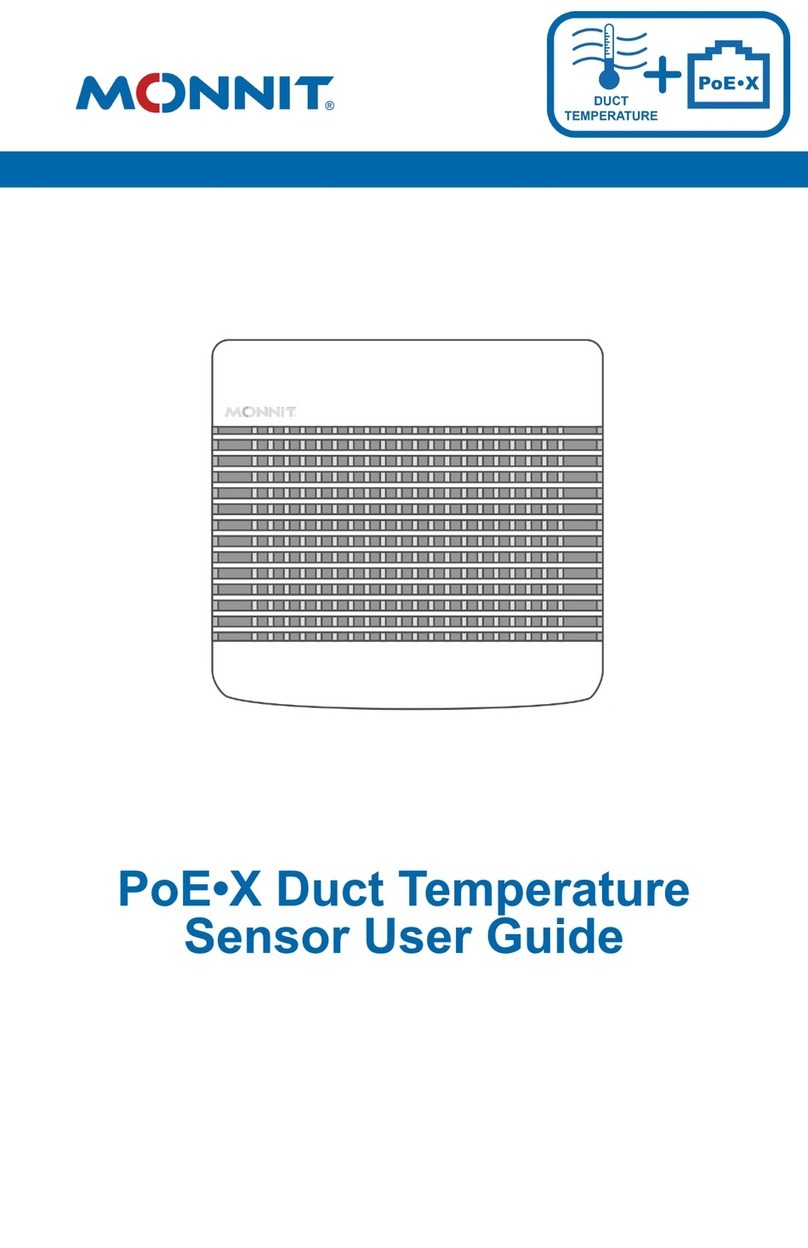
Monnit
Monnit PoE-X Duct Temperature Sensor user guide

SmartSense
SmartSense Temp/Humidity Booklet
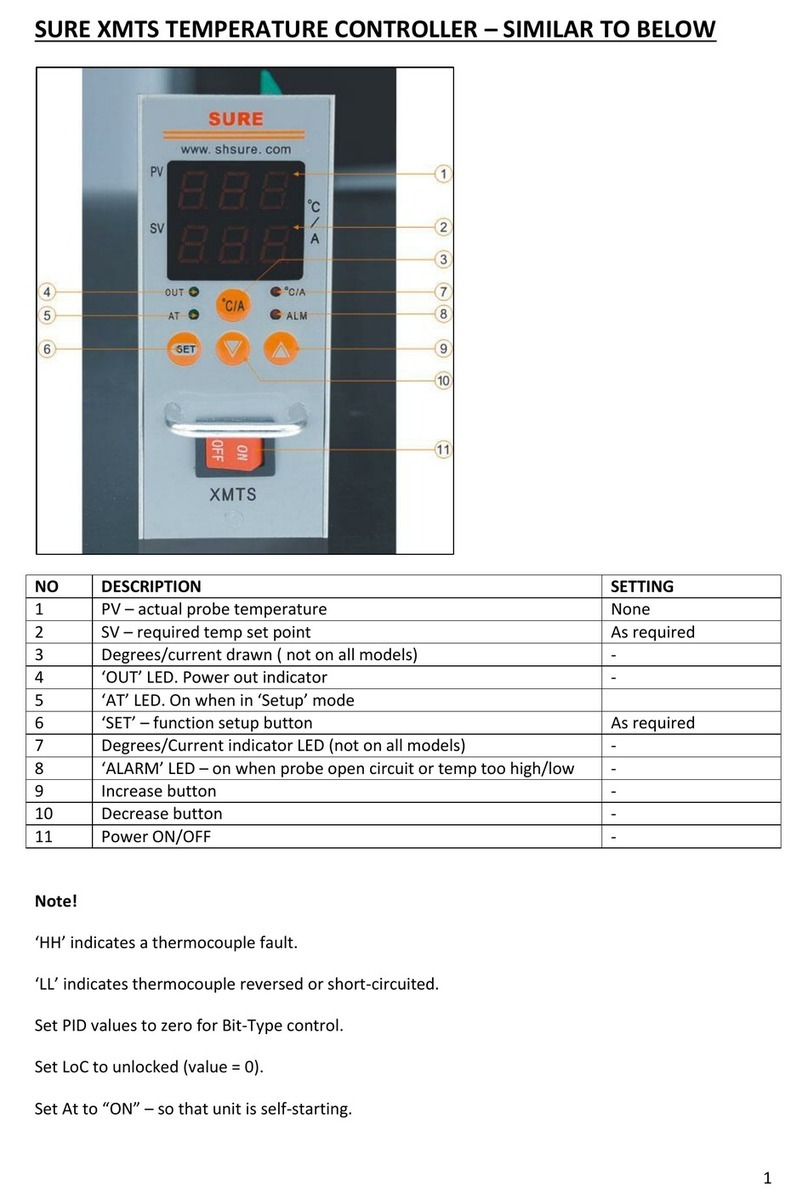
Sure Electronics
Sure Electronics XMTS quick start guide
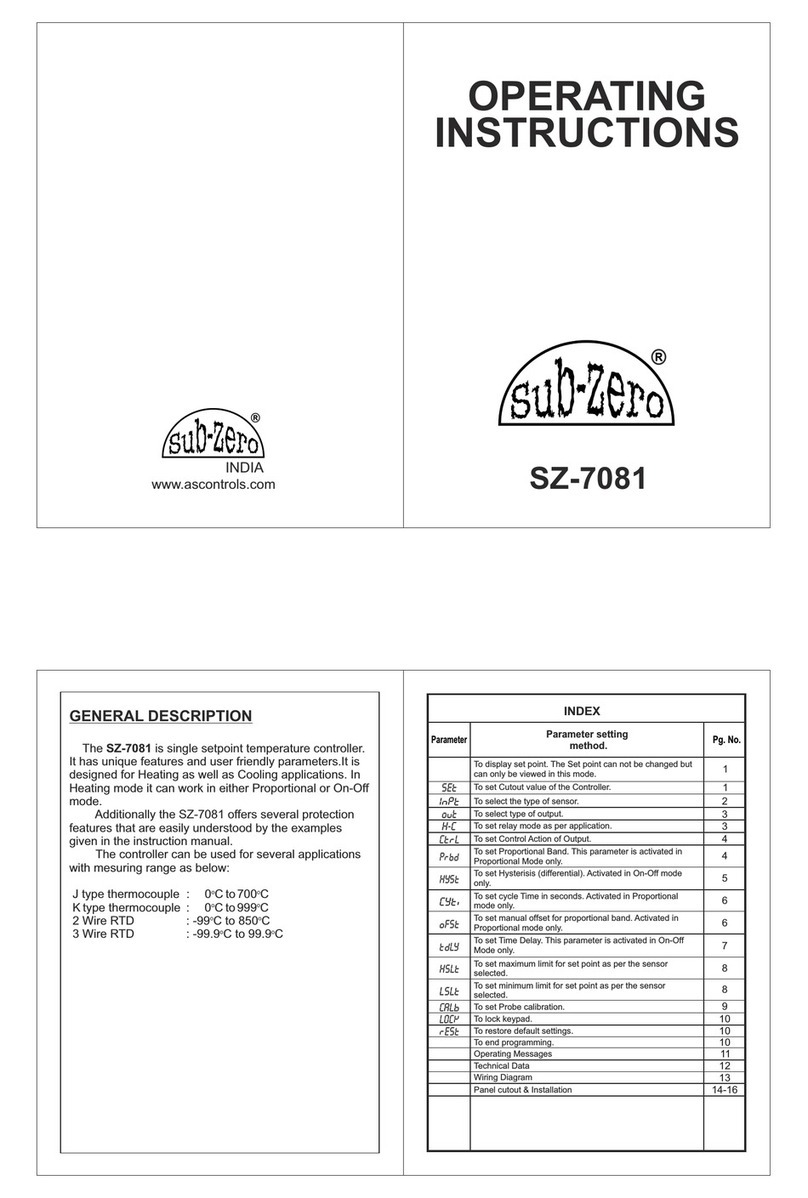
Sub-Zero
Sub-Zero SZ-7081 operating instructions

Automationdirect.com
Automationdirect.com SOLO SL4896 Series Quick start guid
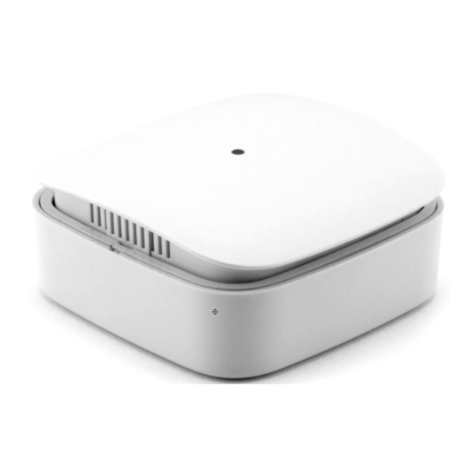
Eurotronic
Eurotronic 700087 Installation & operation guide
